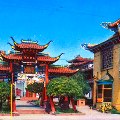
Ethnic Neighborhoods – Los Angeles
Los Angeles has the highest concentration of Mexicans outside Mexico, Koreans outside Korea, and even Samoans outside Samoa. Tiny Russian, Ethiopian, Armenian, and even British enclaves also coexist throughout L.A. But to call the city a “melting pot” wouldn’t be quite accurate; it’s really more of a tossed salad, composed of distinct, albeit overlapping, cultures.
Boyle Heights
East of Downtown; bounded by U.S. 101, I-10, Calif. 60, and Indiana St.
In the first decades of the 20th century, Boyle Heights was inhabited by Jewish immigrants, who have since migrated west to the Fairfax district and beyond. They left behind the oldest orthodox synagogue in Los Angeles, and Brooklyn Avenue, which has since been renamed Cesar E. Chavez Avenue. Boyle Heights is now the heart of the Latino barrio.
Chinatown
Downtown; bounded by N. Broadway, N. Hill St., Bernard St., and Sunset Blvd.
Many Chinese settled in this once-rural area during the second half of the 19th century. Today, most Angelenos of Chinese descent are well integrated into the city’s suburbs; few can be found living in this rough pocket of Downtown. But though the neighborhood hardly compares in quality or size to the Chinese quarters of London, San Francisco, or New York, Chinatown’s bustling little mom-and-pop shops and profusion of ethnic restaurants provide an interesting Downtown diversion. Chinatown is especially worth going out of your way for during Chinese New Year, a month-long celebration that usually begins in late January.
El Pueblo de Los Angeles
Enter El Pueblo Historic Monument via Alameda St. across from Union Station.
This historic district was built in the 1930s on the site where the city was founded, as an alternative to the razing of a particularly unsightly slum. The result is a contrived nostalgic fantasy of the city’s beginnings, a kitschy theme park portraying Latino culture in a Disney-esque fashion. Nevertheless, El Pueblo has proven wildly successful, as L.A.’s Latinos have adopted it as an important cultural monument.
Koreatown
West of Downtown; bounded by Wilshire Ave., Crenshaw Blvd., Olympic Blvd., and Vermont Ave.
Here’s something you probably didn’t know: There are more Koreans in Los Angeles than anywhere else in the world outside of Korea — some 100,000. If you drive down Western Avenue between Olympic and Wilshire boulevards it won’t take much imagination to believe that you’re suddenly in a section of Seoul. Hundreds of signs in Korean script are bolted onto dozens of minimalls and office buildings within this vibrant commercial district.
Leimert Park Village
Southwest of Downtown; bounded by Crenshaw Blvd., Vernon Ave., Leimert Blvd., and 43rd Place.
The neighborhood around tiny Leimert Park is becoming a center of African-American artistic life and culture. It features galleries, restaurants, and shops filled with local crafts and African imports. Folks flock here to jazz clubs that evoke the heyday of L.A.’s Central Avenue jazz scene, when greats like Ella Fitzgerald mesmerized audiences. In December, Kwanzaa celebrations further enliven Leimert Park.
Little Tokyo
Downtown, southeast of the Civic Center; bounded by 1st, 2nd, San Pedro, and Los Angeles sts.
Like nearby Chinatown, this redeveloped ethnic neighborhood isn’t home to the majority of Angelenos of Japanese ancestry; suburban Gardena has that distinction. But Little Tokyo functions as the community’s cultural focal point and is home to several malls filled with bakeries, bookshops, restaurants, and boutiques, as well as the occasional Buddhist temple. The Japanese American National Museum is here, as is the Japanese American Cultural and Community Center.